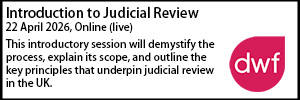
A short guide to shared legal services
- Details
The LexisPSL Local Government team explain the background to and advantages and disadvantages of shared legal services in achieving improved cost efficiency within the public sector.
One of the biggest management factors for local authorities in moving towards shared legal services is improving cost efficiency. The Government’s current deficit reduction plan requiring public bodies to make significant savings until at least 2018–19 has given an added urgency and impetus for local authorities to consider their options in that regard.
The Local Government Association currently estimates that there are 416 shared services across the country (including shared IT systems, fire services, back-office and professional services and some front-line services) which have achieved a £462m saving to date.
In terms of local authority legal departments, shared legal services can be very beneficial in drawing on existing expertise, capacity and purchasing power, and in some cases even creating profit by turning the shared services into a commercial venture.
What are the potential advantages of shared services?
● Reducing duplication and benefitting from cost savings through pooled resources, knowledge and expertise, which can be extremely useful where one local authority has particularly strong legal expertise in an area (for example child care), but less so in another (for example planning).
● Increased efficiency and productivity by streamlining processes, introducing common standards and making full use of capacity.
● Depending on the size and type of the shared service, implementation costs may be kept fairly low.
● Ability to purchase legal services from other local authorities, with the benefit of the partner authority having in-depth knowledge of the culture and workings of local authorities.
● Potential financial benefits in selling legal services in the event of spare capacity – shared legal services are already being sold to other local authorities, combined authorities, arms-length management organisations, charities and not-for-profit organizations, blue light services, housing associations, and schools (academy, free and maintained).
What are the potential disadvantages of shared legal services?
● Viability of the model, upfront cost, procedures (i.e. any procurement process required, Solicitors Regulatory Authority (SRA) compliance if applicable) and disruption cancelling out long-term savings. This will largely depend upon the size and type of the model chosen.
● Disconnect between legal teams and local authorities if they are not working exclusively and closely with their own authority.
● Conflict of interest between prioritising work for own authority versus partner local authority.
● Cultural fit and decision-making process issues. These issues need to be considered and streamlined so far as possible from inception.
What are the delivery models for shared legal services?
Multi-authority collaborative arrangements may take a number of forms, i.e.:
● Partnership arrangements with other local authorities including sharing work, allowing partner authority legal teams to retain independent status.
● Fully integrated shared services teams i.e. local authorities merging their own legal departments to create a shared legal service to be managed jointly or by a lead partner. This arrangement can be documented by way of a memorandum of understanding or other agreement setting out the parties’ respective responsibilities etc.
● Establishing a joint committee with representatives from all partners to which the service functions could be delegated under ss101 and 102 of the Local Government Act 1972.
● Joint procurement of external provider to deliver shared legal services to all of the authorities. This can be achieved through public sector partners, or public and private sector partnerships. This external provider may be wholly owned by partner authorities, or may be a private sector service provider. An important consideration in using an external provider is whether or not the scale of the proposed shared services makes it viable to go through any tendering process required in the event that the model requires compliance with procurement regulations. Using this type of model may also allow local authorities to turn the shared services into a commercial venture by providing services for profit. There are a number of contractual structures for this model, including framework agreements entered into by lead partners and consortium agreements with all partners.
Examples of shared legal services
There are already numerous shared legal services models in existence including:
● LGSS: a merger of Cambridgeshire and Northamptonshire county councils corporate services into a single shared service, which is now a law firm wholly owned by the councils, specialising in services to the public sector. LGSS has partnerships across the region with a number of other public sector organisations, including other councils and also NHS bodies, adult care services and education bodies.
● HB Public Law is also a single shared service working with other public sector organisations.
● EM Lawshare: an East Midlands consortium with 87 members from various public sector organisations and six partner firms which deliver the whole range of legal advice at discounted rates. Partner firms receive a substantial amount of work and accordingly offer added value such as free training. The consortium is governed by a full tendered framework agreement, and is non-exclusive meaning members are free to instruct other firms. Another consortium with a similar set up is the North West Legal Consortium, which has 43 members, three partner firms and a barristers portal with 20 sets of chambers registered and offering discounted hourly rates and fixed fees in a range of areas.
● Public Law Partnership: this has 30 members in the East of England. There is no framework agreement with private sector law firms because the aim is to carry out as much work and knowledge sharing as possible within member LAs.
If you would like to read more quality articles like this, then register for a free 1 week trial of LexisPSL at www.lexisnexis.co.uk/en-uk/products/pslfreetrial.page
 This article appeared in the Legal Department of the Future report, published in February 2016. To read or download the full report, please click on the following link: http://www.localgovernmentlawyer.co.uk/ldotf/
This article appeared in the Legal Department of the Future report, published in February 2016. To read or download the full report, please click on the following link: http://www.localgovernmentlawyer.co.uk/ldotf/
+
Legal Director - Government and Public Sector
Principal Lawyer - Planning, Property & Contract
Senior Lawyer - Planning, Property & Contracts Team
Solicitor/Lawyer (Contracts and Procurement)
Locum roles
 File it Right: A Guide to Reporting for Registered Providers and Group Structures
File it Right: A Guide to Reporting for Registered Providers and Group Structures
15-01-2026 11:00 am
Online (live)
 Masterclass – MCA and Court of Protection - Legal Update - Peter Edwards Law Training
Masterclass – MCA and Court of Protection - Legal Update - Peter Edwards Law Training
21-01-2026
Online (live)
 Managing settlements: the legal and practical issues, and the pitfalls to avoid - Blake Morgan
Managing settlements: the legal and practical issues, and the pitfalls to avoid - Blake Morgan
22-01-2026 10:00 am
Online (live)
 Children and Young People (DoL, Competency and Capacity) - Peter Edwards Law Training
Children and Young People (DoL, Competency and Capacity) - Peter Edwards Law Training
28-01-2026
Online (live)
 CCTV, Drones and Body Worn Cameras: Ensuring Data Protection Compliance - Act Now
CCTV, Drones and Body Worn Cameras: Ensuring Data Protection Compliance - Act Now
30-01-2026 10:00 am
Online (live)
 Construction: Recourse through the Building Safety Act – Where did we land in 2025? - Devonshires
Construction: Recourse through the Building Safety Act – Where did we land in 2025? - Devonshires
03-02-2026 2:00 pm
Online (live)
 HMPL Building Blocks: Legal Tools to Combat Anti-Social Behaviour - Devonshires
HMPL Building Blocks: Legal Tools to Combat Anti-Social Behaviour - Devonshires
17-02-2026
Online (live)
 Data Controller, Processor or Joint Controller: What am I? - Act Now
Data Controller, Processor or Joint Controller: What am I? - Act Now
18-02-2026 10:00 am
Online (live)
 Freedom of thought, belief and religion: Article 9 ECHR - Francis Taylor Building
Freedom of thought, belief and religion: Article 9 ECHR - Francis Taylor Building
19-02-2026
Online (live)
 AI and Information Governance: Bridging Innovation and Compliance - Act Now
AI and Information Governance: Bridging Innovation and Compliance - Act Now
19-02-2026 10:00 am
Online (live)

























































































































 Cyber Security for DPOs - Act Now
Cyber Security for DPOs - Act Now  Enforcement Notices - Getting the notice right - Ivy Legal
Enforcement Notices - Getting the notice right - Ivy Legal  Standish 18 months on - 42BR
Standish 18 months on - 42BR  Accelerating EV Charging Infrastructure in the Public Sector - DWF
Accelerating EV Charging Infrastructure in the Public Sector - DWF  Building Safety Act Conference 2026 - Landmark Chambers
Building Safety Act Conference 2026 - Landmark Chambers  Education Law Conference - 3PB
Education Law Conference - 3PB 